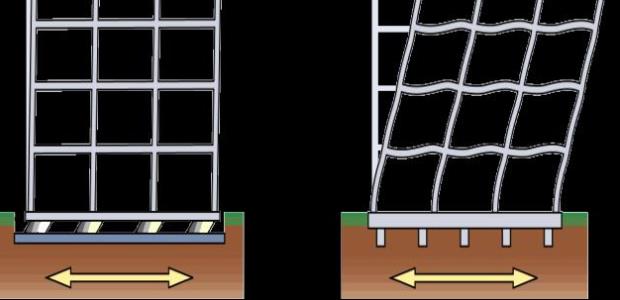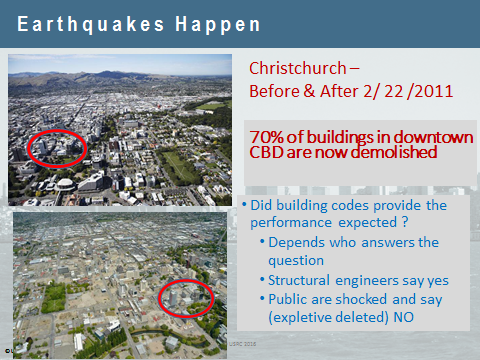
Page 5 of 4
Building Performance in Earthquakes and the U.S. Resiliency Council's Rating System
Maybe it's the office building where you work. Maybe it's the multi-story apartment complex where you live.
Do you have any idea how it will perform in the next major earthquake?
The design philosophy of current building codes states that they are intended to minimize risk against major failures and loss of life, not to limit damage, maintain functions, or provide for easy repairs. This often comes as a surprise to many building owners and occupants who believe they are getting an "earthquake proof" building when they hire a competent structural engineer to design a code-conforming building. Code-designed buildings are designed to avoid collapsing during a major earthquake but aren't quite up to the task of remaining inhabitable after disaster strikes. In fact, a modern building designed to the current code could be condemned and demolished immediately after a large earthquake.
If more building owners, residents, and landlords were aware of the gap between current building code and how performance during earthquakes could be rated and improved upon, things would be different.
Building Performance in Past Earthquakes
As we have painfully learned in many recent disasters ($30B in 1994 Northridge, $170B in 1995 Kobe, $20B in 2011 Christchurch, New Zealand, and $300B in 2011 Eastern Japan earthquakes), the major economic issues relate not only to the direct cost of earthquake damage, but also to the business disruption costs associated with the loss of one or more buildings for significant periods of time. These include loss of production or operations, loss of sales or services, and loss of ongoing research and development in some industries (e.g., the biotech industry). These losses translate into major economic issues for a corporation, including loss of revenue, loss of market share, and loss of share value. Clearly, these business disruption costs overwhelm any first-cost considerations.
 A recent example of the mismatch in public expectations was the performance of a full range of old and modern buildings in the Central Business District of Christchurch, New Zealand, during the February 2011 earthquakes. The New Zealand codes are similar to those used in the United States. Two buildings collapsed, but the others performed as expected by the structural engineering profession in that they provided life safety for the occupants. What was not expected by the public at large was the need to demolish 70 percent of the buildings in the CBD due to the damage they had sustained.
A recent example of the mismatch in public expectations was the performance of a full range of old and modern buildings in the Central Business District of Christchurch, New Zealand, during the February 2011 earthquakes. The New Zealand codes are similar to those used in the United States. Two buildings collapsed, but the others performed as expected by the structural engineering profession in that they provided life safety for the occupants. What was not expected by the public at large was the need to demolish 70 percent of the buildings in the CBD due to the damage they had sustained.
The notion that there is a disconnect between the anticipated performance of buildings in a major earthquake and what the public understands or expects is not new. The thought was that if the public could be made more aware of their potential seismic risk, they could be expected to make better-informed decisions on owning and leasing properties, and market forces would eventually drive the building design, management, and procurement process into more resilient seismic design.
A building rating system will help owners, tenants, investors, and other stakeholders understand how a building will perform in the next large earthquake. Without it, many owners may be surprised and disappointed with how their code-compliant buildings fare. A building rating system that is designed to speak to the population as a whole, in terms that are understandable and meaningful in their day-to-day decision-making, has the potential to change the game in risk communication and elevate seismic performance considerations into everyday conversations involved in building, buying, or leasing a building.
The U.S. Resiliency Council and its Building Rating System
The United States Resiliency Council (USRC, www.usrc.org) was launched in November 2015, and its mission is to establish and implement building rating systems that describe the performance of buildings during earthquakes and other natural hazard events, to educate the general public to understand these risks, and thereby improve societal resiliency.
The creation of the U.S. Resiliency Council comes at a time when the federal government has recognized the need for long-term resiliency planning of its infrastructure, critical facilities, and communities. The steadily increasing economic and social losses in U.S. disasters and the awareness of the potential effects of catastrophic events on an increasingly dense and unprepared population are a clear call for more consistently applied assessment techniques to measure building resiliency.
The USRC is in a unique position to transform the way earthquake performance of new and existing buildings is perceived by clients and the public. It offers a technically defensible and replicable methodology for implementing a consistent and measurable rating system. The USRC is modeled after the U.S. Green Building Council (USGBC®). Like the USGBC, the USRC issues ratings, certifies practitioners, and technically reviews ratings shared with the public so that USRC ratings are credible and consistent. Ratings will benefit building owners, lenders, tenants, and government jurisdictions by increasing the value of well-designed properties as well as retrofitted existing buildings. Policy makers will use USRC ratings to compare and prioritize relative risks and to form a basis for developing long-term resilience policy.
The USRC Rating System consists of three dimensions (safety, repair cost, and time to regain basic function):
- The Safety rating dimension addresses thresholds for the building in terms of the potential for people in the building to get out after an earthquake event and avoid bodily injuries or loss of life.
- The Repair Cost rating dimension is an estimate of the cost to repair the building after the earthquake event. Repair cost is defined as a percentage of the building's overall replacement cost prior to the earthquake.
- The Time to Regain Basic Function rating represents an estimate of the minimum timeframe to carry out sufficient repairs and to remove major safety hazards and obstacles to regain occupancy and use of the building, but not necessarily restore it to its full intended functions and operations as it existed prior to the earthquake.
Within each dimension, definitions are keyed to five levels of performance. Levels of performance are communicated using star symbols, with more stars equating to higher (or better) performance. The current rating dimensions and performance level definitions are shown on the USRC web site. The USRC Rating System has a color overlay of platinum, gold, silver, and bronze ratings as shown here. A building designed to current codes will as a minimum have a bronze rating and in all likelihood will be silver rated, but not a gold or platinum rating.
The USRC Rating System will:
- Communicate levels of performance to broad-based, non-technical audiences
- Address new and existing buildings in a consistent context
- Correct popular misconceptions about expected building performance
- Provide multiple measures of performance to suit different decision-making needs
- Provide a context for public policy decisions and market forces to encourage and reward better-performing designs
The rating system is usable by all occupants, buyers, sellers, and tenants of a building. The greatest value of a system is one that meshes with economic decisions. Thus, there are a number of potential applications, with an important one being a building rating that is disclosed as part of a real estate sales transaction. In the context of a sales transaction, we envision that market pressures would encourage buyers and/or sellers to obtain a rating, making it part of pre-purchase due diligence. A related situation that could initiate a rating to be obtained is a lease turnover. A range of other potential uses includes:
- New construction as part of a permit process
- Voluntarily by developers if market demand is perceived
- Required as part of the permit process
- Required by lenders and insurance companies
- Public buildings
- Occupants’ right to know
- Existing buildings in place of a retrofit mandate
- Provides information for tenants and leases to make more rational decisions; they may be happy to pay a lower rent for a higher-risk building.
The USRC building rating system that is designed to speak to the population as a whole, in terms that are understandable and meaningful in their day-to-day decision-making, has the potential to change the game in risk communication and elevate seismic performance considerations into everyday conversations involved in building, buying, or leasing a building.
Improved Earthquake Performance
There are two technologies that provide much better performance than a conventional code-designed building and will provide USRC platinum or gold performance in an earthquake: base isolation and distributed fluid viscous dampers. Base isolation is a design method used to substantially decouple the response of a structure from potentially damaging horizontal components of earthquake motions by inserting isolators at the base of a structure. Distributed viscous dampers, on the other hand, are inserted in the structure and dampen or reduce the motion of the structure once shaking begins.
Many structures throughout the world have already taken advantage of these technologies to provide much better performance during earthquakes. Dampers and isolators operate like shock absorbers on automobiles. Why should buildings in earthquake zones be designed without them? These types of devices are not expensive and have proven to offer superior benefits—the additional construction costs are in the 1 to 10 percent range.
The thought is to put some of the energy of the earthquake into dampers or, in the case of base isolation, reduce the motion to which the structure is subjected. The good news is that these devices can be easily integrated into the design of new structures by the engineers if building owners are seeking to provide better performance for their buildings. Additionally, older structures can be retrofitted with dampers or isolators, rather than waiting for the next large earthquake with fingers crossed. Many already have.
Resilience is the Ability to Recover After a Disaster
Measuring and improving the resiliency of the country’s communities is a national imperative, and there are a number of major efforts in progress in the United States to address this issue. A partial summary includes:
- Los Angeles City: Resilience by Design
- San Francisco City: Resilience Strategy and Earthquake Implementation Program
- Alliance of National and Community Resilience
- 100 Rockefeller Cities Initiative
- National Institute of Standards and Technology's (NIST) Community Resilience Panel for Buildings and Infrastructure Systems
- National Institute of Building Sciences—Developing Pre-Disaster Resilience Based on Public and Private Incentivization
- National Resilience Initiative by the Foundation of the American Institute of Architects
- U.S. Green Building Council’s new initiative for three pilot resilience points
There are also many other efforts at both the state and local levels. What all of these initiatives have in common is the need to understand the performance of the building stock in a community in terms of safety and recovery.
This article originally appeared in the May 2017 issue of Occupational Health & Safety.
About the Authors
Ron Mayes is the Board Chair of the U.S. Resiliency Council.
Evan Reis is the Executive Director of the U.S. Resiliency Council (www.usrc.org).
Alan Klembczyk is Vice President, Sales & Engineering, for Taylor Devices, Inc. (www.taylordevices.com) of North Tonawanda, N.Y.